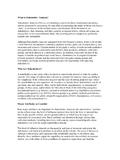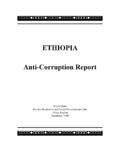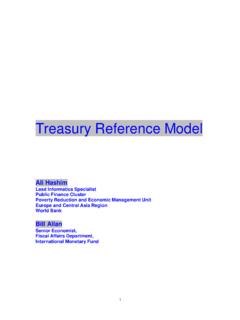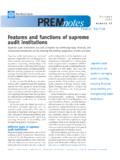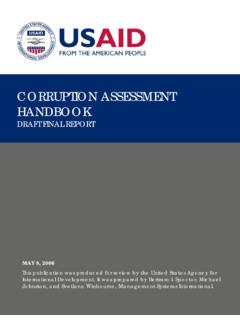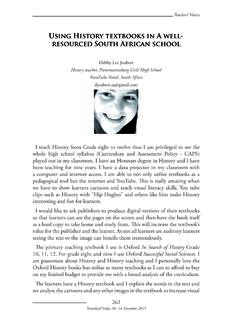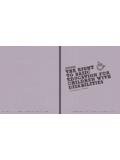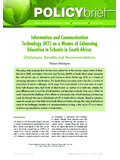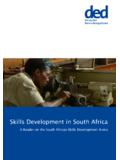Transcription of Executive Summary - World Bank
1 Part 21 Executive SummaryThe focus of this case study of education reform is limited to three specific interventions by the SouthAfrican government: education finance reform, curriculum reform, and the teacher rationalization pro-cess. These three interventions were sampled from a rich mix of reforms because they were initiatedvery early in the democratic transition and because there is a reasonably sound empirical base fromwhich to make judgments about the efficacy and effectiveness of these interventions. This case studyof educational reform in south Africa will present a critical analysis of the reform goals, design, imple-mentation, and impact for each of the three interventions.
2 In the end, the objective of this case reportis to contribute new insights and understandings to the global knowledge base on education reforms indeveloping post-apartheid government of 1994 inherited one of the most unequal societies in the of social and economic discrimination against black south Africans left a legacy of incomeinequality along racial lines. Furthermore HIV/AIDS constitutes a massive threat to development inSouthern Africa. In the general population, 11 percent of south Africans from all walks of life are HIV-positive, with percent of this group aged between 15 and 49.
3 Higher rates of infection are found inchildren aged between 2 and impacts education policy reform goals in a number of ways. It erodes participation gains thatresulted from reform attempts to broaden access to primary, secondary, and tertiary education giventhat more and more students either die or drop out of school because of personal illness (HIV/AIDS-infected) or family illness (HIV/AIDS-affected). Indeed high infant mortality rates mean that fewer stu-dents than expected show up for the first year of schooling. Second, HIV-AIDS erodes quality gainspremised on the availability of trained and experienced teachers to deliver on new curriculum or as-sessment reforms in the sense that more and more teachers are leaving the education system be-cause of illness or death.
4 The AIDS pandemic is also eroding potential economic gains from highereducation delivering an increasingly skilled pool of graduates. Fourth, it erodes equity gains embeddedin post-apartheid policy given that mainly black and female students are infected and leave theeducation system the response of the south african government has been to acknowledge the crisis in the form ofstrategic plans, major policy conferences, and statements on the part of the Department of Education,these broad policy positions and program interventions have to date shown little impact. One of theprincipal reasons for the inability of the education system to make discernible progress in the fightagainst AIDS is the presence of a high-profile public debate, stirred by leading politicians, about thenature, extent, and even the causes of the disease.
5 In addition, there is widespread denial about thecauses of death of AIDS victims. Under these circumstances, it is not surprising that educationalprograms aimed at limiting the spread of the disease and dealing with its consequences have re-mained marginal and stigmatized at the edges of the school Change in south Africa, 1994-20032 The new south african state has achieved a number of notable successes in the post-1994 , the creation of a single national department of education out of 19 racially, ethnically, andregionally divided departments of education was a very significant accomplishment in the early creation of non-discriminatory school environments into which access was gained on the basis ofcriteria other than race or religion was also a very significant achievement of the new government.
6 Thecreation of new institutional typologies is one of the most recent accomplishments; this includes thecreation of 50 Further Education and Training Colleges (FETs) out of 150, the incorporation of collegesof education into universities, and the merging of technikons and universities in various delivery of certain basic services, such as the supply of electricity, water, toilets, computers, andtelephones has clearly improved in the last nine a result of these gains, south Africa has been able to achieve among the highest enrollment ratesin african education. More than 12 million learners attend school, with gross enrollment ratios averag-ing over 100 percent for primary schooling and over 70 percent for secondary schools.
7 The rate of girls participation in schooling is one of the continent s the field of fiscal reform, there has been a significant increase in education expenditures since 1994,with a reconstitution of the national budget away from security concerns and toward social several measures have been instituted with a view to redistributing funds towards thoseparts of the system disadvantaged by apartheid, such as weighting provincial and school allocationsaccording to poverty considerations, through special funding programs such as school nutritionschemes and transport subsidies to advance access to schooling, and through exemption legisla-tion to reduce the direct costs of schooling (such as school fees) for poor manifest inequalities between schools persist for a number of reasons.
8 First, the sheer extentof the backlogs in apartheid education requires a much greater investment than has been achievedthrough existing levels of budgetary allocation. A second major source of inequality between schoolsarises from the ability of more privileged schools to very significantly supplement government grantsthrough school fees. Third, the management capacity of provincial education departments to deliver onallocated budgets remains a primary explanation for under-spending on schools in the poorest prov-inces and hence, of inequity in the recent Department of Education report investigated ways of establishing greater equity in the distri-bution of resources.
9 The Minister has acted on some of these findings, announcing that schoolsserving the poorest children would receive a basic grant to cover essential non-personnel, teacher rationalization initiative was an early attempt by the new government to redistribute spend-ing through the more equitable deployment of teachers by far the largest budget item. An analysis ofthis initiative is instructive in revealing the government s difficulties in effecting these goals. The pro-gram is likely to have given poor schools increased resources in the form of more teachers andrelatively higher teacher to pupil ratios than they had under apartheid, although it is not possible to bedefinitive about this in the absence of reliable data.
10 However overall equity in the distribution of teach-Part 23ers is likely to have diminished, through a large increase in the number of teachers employed byschool governing bodies (SGBs) and a huge rise in the SGB to total teacher ratio, almost certainlyconcentrated in schools serving richer communities. In order to ameliorate this situation, the govern-ment is considering adjusting the post-provisioning model, a formula for allocating teachers to schools,so as to increase the bias towards poorer the government s best efforts, it would seem that, because of the ability of the middle class tosupplement state expenditure in very significant proportions, absolute equity in spending is only at-tainable by limiting parents contributions.

